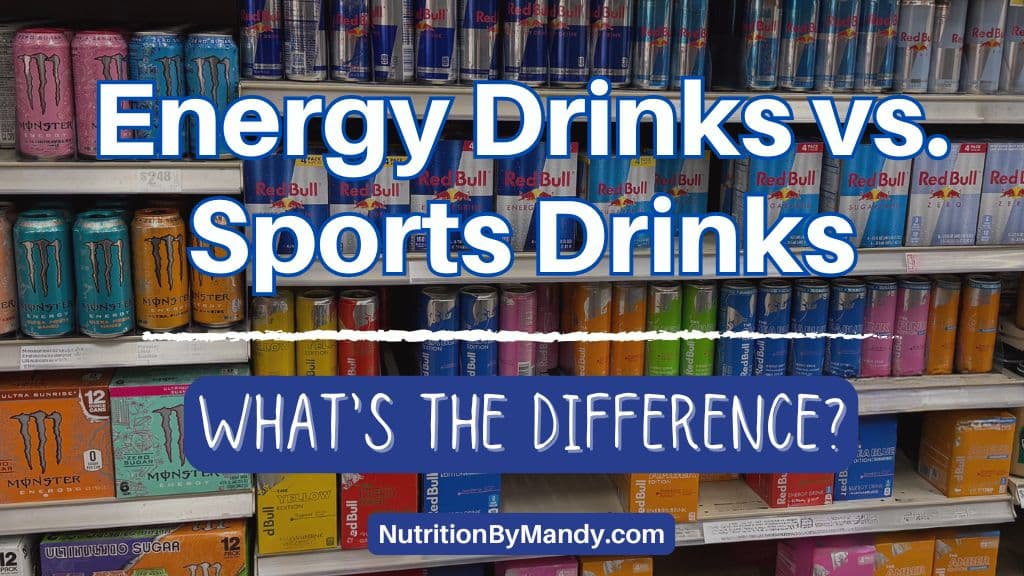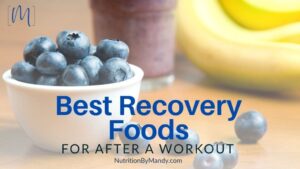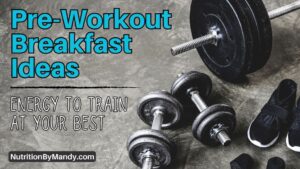Last Updated on September 8, 2025 by Mandy Tyler, M.Ed., RD, CSSD, LD
Energy Drinks vs. Sports Drinks: What’s the Difference?
With all the new beverages on the market it can be confusing to know the differences between energy drinks and sports drinks.
Although both drinks are commonly marketed as drinks for athletes and active individuals, there can be a major difference in the ingredients the drinks contain.
Let’s compare energy drinks vs. sports drinks so you can be confident in knowing the difference.

Energy Drinks vs. Sports Drinks
What is a Sports Drink?
Sports drinks are designed to support the hydration and energy needs of athletes engaged in physical activity. Typically, sports drinks are formulated to contain fluid, electrolytes, and carbohydrates (1).
When consumed during activity, the fluid and electrolytes help to replace sweat losses. The carbohydrates in the sports drink provide energy for the working muscles.
Are All Sports Drinks the Same?
It is important to recognize that not all sports drinks contain the same types or amounts of carbohydrates and electrolytes.
It used to be when we talked about sports drinks everyone assumed we were referring to Gatorade. Now there are numerous different types of sports drinks available at the store, which can make it confusing for athletes.

What to Look for in a Sports Drink
When selecting a sports drink to consume during activity, athletes should look for one that contains carbohydrates, sodium, and a small amount of potassium.
Sodium is the main electrolyte lost in sweat. Thus, replacing sodium during activity is important for athletes, especially for those athletes who are “salty sweaters.”
When selecting a sports drink to consume during activity, look for one that contains the following (1):
- Carbohydrates: 12-18 g per 8 oz (6-8% solution)
- Sodium: 110-170 mg per 8 oz (20–30 meq per L)
- Potassium: 20-50 mg per 8 oz (2–5 meq per L)
Make sure to review the nutrition facts label on your sports drink to see if it contains the nutrients needed in the correct amounts for competition.
Note: Some athletes are “salty sweaters” and lose a high amount of sodium in their sweat. These athletes may benefit from a sports drink with a higher concentration of sodium (i.e. endurance formula). I encourage these athletes to work with a sports dietitian nutritionist to assist them with developing an individualized hydration plan for activity.
What About Potassium in Sports Drinks?
Recently there has been an increase in the number of sports drinks made with coconut water. These beverages have a higher potassium content and also tend to be much lower in sodium.
Examples of beverages with a high potassium content include Prime Hydration and Body Armor.
Although potassium is an important nutrient, with many essential roles in the body, the main electrolyte the body loses in sweat is sodium. Therefore, during exercise athletes should choose a beverage containing a higher sodium than potassium concentration.
If athletes what to enjoy the higher potassium beverages outside of activity to stay hydrated that is fine. However, it would not be a beverage I suggest athletes hydrate with during practices or competitions.

When to Choose a Sports Drink
I commonly remind athletes that sports drinks are intended for SPORTS (when participating in physical activity).
General guidelines for when athletes should choose a sports drink include (1, 2):
- Athletes will be exercising over 1 hour
- Athlete has multiple games or workouts in the same day
- Athlete has a morning practice and did not eat prior to the workout
- When it is hot and humid outside
Energy Drinks vs. Sports Drinks
What is an Energy Drink?
Energy drinks first hit the market in the United States in the 1990s and have been growing in popularity since this time (3, 4).
There are now a wide variety of energy drinks for sale in the United States. The drinks may range in size from large, 16 oz cans, to small, 2.5-oz energy shots (3).
It is common for energy drinks to be marketed to athletes and young adults with claims of improving performance, reducing fatigue, enhancing concentration, and boosting energy levels (4, 5).

Energy Drink Ingredients
Energy drinks are typically formulated to contain caffeine along with a blend of ingredients aimed at increasing energy levels.
The exact formulation of ingredients within energy drinks varies by brand and product. However, common ingredients added to energy drinks include (3, 4, 5):
- Caffeine
- Taurine, ginseng, guarana
- L-Theanine, carnitine, tyrosine
- Yerba mate, herbal extracts
- B Vitamins, niacin
- Sugar or artificial sweeteners
- Electrolytes: Sodium, potassium, magnesium, calcium
Energy Drink Proprietary Blends
Many energy drinks contain a “proprietary blend” of ingredients. On the drink’s label the ingredients contained within the blend are required to be listed. However, the company does not have to list the amount of each ingredient within the blend (6).
Energy drink companies may choose to list a “proprietary blend” on the label to protect their formula / unique blend from competitors (6).
However, the use of a “proprietary blend” poses a challenge to consumers trying to determine the content and potential benefit of the drink they are consuming.
Concerns with Proprietary Blends
As a sports dietitian, it is not possible for me to fully evaluate nor provide a recommendation on an energy drink that contains a “proprietary blend.”
If the amount of an ingredient in the beverage is not provided, I cannot determine if there is enough of the ingredient within the drink to be beneficial. Conversely, there may be more of the ingredient in the drink than is necessary or recommended (3).
I frequently tell athletes that if an energy drink contains a “proprietary blend” they should not consume it. It is important to know both the type and amount of ingredients contained in the energy drink to determine if it is appropriate to consume.
Caffeine in Energy Drinks
Caffeine is often one of the main ingredients contained in energy drinks (3). The caffeine content of energy drinks varies depending on the brand and product purchased.
To provide an example, the caffeine content of several varieties of energy drinks are listed below (7).
- Celsius (12 oz can): 200 mg caffeine
- Red Bull (8.4 oz can): 80 mg caffeine
- 5-Hour Energy (1.9 oz shot): 200 mg caffeine
However, as discussed above, aside from the caffeine, many energy drinks contain a variety of added ingredients. Some of these ingredients, such as guarana, also have stimulatory effects in the body (4).
My concern is that there is very limited research available on the potential interactions of the ingredients contained within these drinks. The combination of ingredients may have a synergistic effect in the body and potentially lead to health concerns (4, 5).
If an athlete desires to consume caffeine, I recommend choosing a product with a known amount of caffeine that does not contain any other ingredients that have stimulatory effects.
Pro Tip: For additional information on caffeine, make sure to check out my blog on caffeine for sports performance.

Energy Drinks: Potential Adverse Side Effects
It is important to note that negative side effects, such as insomnia, jitters, irritability, nausea, elevated blood pressure, and cardiac arrhythmias, have been reported following the consumption of energy drinks (3, 5).
Given the wide variety of products on the market, each with unique combinations of ingredients, it is difficult to identify the exact cause of the side effects
If an athlete chooses to drink an energy drink, they should carefully evaluate the ingredients contained within the beverage and be aware of the potential side effects (3, 5).
In addition, I urge athletes to avoid consuming multiple energy drinks (or energy drinks along with other drinks containing caffeine) within the same day, as this may increase the risk of negative side effects (3, 5).
Energy Drinks: Guidance for Coaches and Parents
The International Society for Sports Nutrition recommends that adolescents (12-18 years of age) use caution and seek parental guidance regarding the consumption of energy drinks (3).
In addition, they state that energy drinks are not recommended for children under the age of 12 or for those who are sensitive to caffeine (3).
Athletes, parents, and coaches should note that many energy drinks, such as PRIME Energy, state that their energy drinks are for ages 18+.
As a mom to a teen athlete, as well as a sports dietitian, I will not allow my children to consume energy drinks or energy shots. It is not worth the risk of potential adverse side effects.
Instead of Energy Drinks Fuel-Up with Carbs and Recover with Sleep
If athletes need more energy, they should make sure they are eating enough calories to support their workouts and daily activities.
Carbohydrates provide athletes with the energy needed to perform at their best. Thus, prior to a workout athletes should fuel-up with a high-carb snack, such as a piece of fruit, pretzels, or granola bar.
Athletes should also make sure they are staying well-hydrated and getting adequate sleep each night to allow their bodies time to rest and recover.

Energy Drinks vs. Sports Drinks: What’s the Difference?
Wrapping up, it’s evident that energy drinks and sports drinks are not the same. During activity, sports drinks are appropriate for supporting athletes with meeting their hydration and energy needs.
Athletes should use caution with energy drinks. If athletes are lacking energy, I recommend they meet with a sports dietitian nutritionist. The sports dietitian can work with the athlete on developing a meal plan that provides them with the energy needed to train and perform at their best.
For additional sports nutrition tips for athletes, make sure to check out my blog on supplements for teen athletes.
Join the Nutrition By Mandy Email List & Get a Free Athlete’s Grocery List
Click HERE to join the Nutrition By Mandy e-mail list. When you join you will receive a free athlete’s grocery list to print and take with you to the store.
About the Author
Mandy Tyler is a Sports Dietitian Nutritionist in the San Antonio, TX area. She is a Registered and Licensed Dietitian, a Board-Certified Specialist in Sports Dietetics, a Licensed Athletic Trainer, and is a Certified Exercise Physiologist through the American College of Sports Medicine. Mandy has experience working with athletes at the high school, collegiate, and professional levels. She believes the key to reaching one’s full potential, both in everyday life and in sports performance, relies on a healthy nutritional foundation.

If you are looking to take your performance to the next level, make sure to check out my new Sports Nutrition Game Day Guide. This downloadable guide is written to help athletes develop an individualized plan to achieve peak performance on game day.





